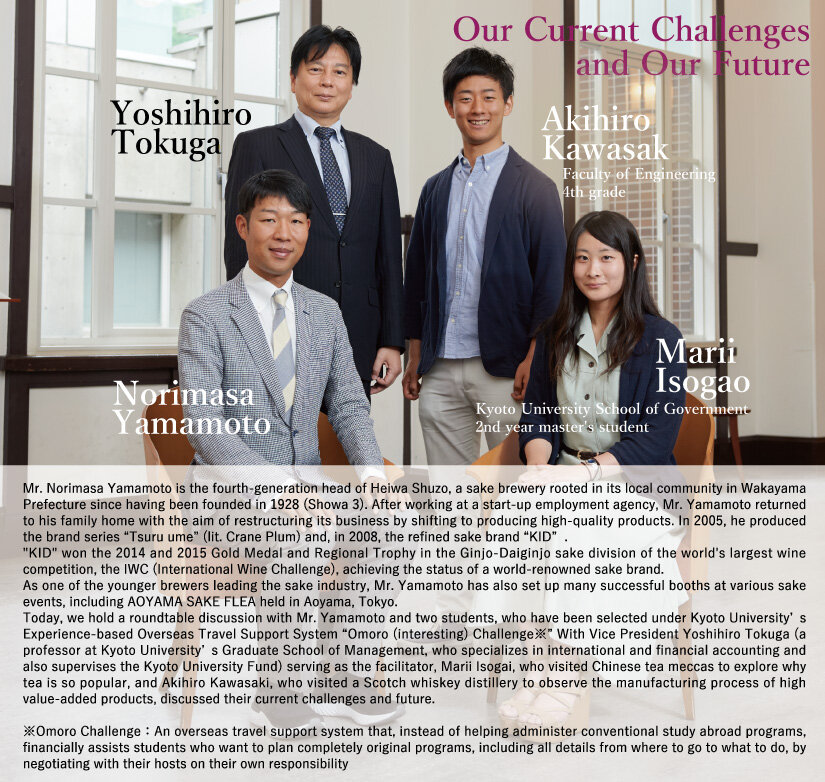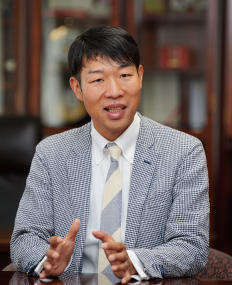Vol.14 Roundtable Discussion between Graduates and Existing Students

Norimasa Yamamoto
Senior Managing Director
Heiwa Shuzo Co., Ltd.
Born in Wakayama Prefecture in 1978. Graduated from Kyoto University's Faculty of Economics in 2003. Joined his family brewery, after working at a startup in Tokyo. Put rigorous efforts unprecedented in the Japanese sake industry into restructuring his family brewery and developing and selling original brand products, after feeling a sense of crisis in its profit structure, which depended on manufacturing low-priced paper pack sake and manufacturing orders outsourced from major brewing companies. Organized a sake tasting event called "The Dawn of the Young" in collaboration with other young brewers around the nation.
Published Monozukuri no risokyo (A Manufacturer's Utopia; dZERO) and co-authored Meido in Japan wo bokura ga sekai he (Our Mission is to Globally Promote "Made in Japan"; dZERO).
Shifting toward brewing high-quality sake
by changing employees' attitudes
Tokuga I am currently interested in the secret to company longevity and have recently noticed that companies that last long continue adapting to the changes of the time. I hear that Heiwa Shuzo will have been in business for a century in another decade, and I understand that it has restructured itself and redesigned its brewing strategy from a longevity perspective.
Yamamoto The sake market is one that is typically called a downward-sloping industry. Over the past 45 years, it has shrunk to 30 percent of its former size. Despite such market conditions, around 2004, when I joined my family business, I noticed it depended on manufacturing low-priced paper pack sake. Feeling a sense of crisis, I said to our employees, "We need to make better sake," but the reaction I got was, "But we already are."
Surviving in a shrinking industry requires producing high-quality products. In our case, we needed to realize that better sake than ours exists and get an idea of the level of our products. So I decided to start by changing our employees' attitudes.
Tokuga How did you do that?
Yamamoto First, I decided to recruit new university and graduate school graduates, which not many breweries do. My aim of recruiting people with a passion for manufacturing was to change the atmosphere of our entire company. I also hoped they could create some kind of added value we could never come up with.
We began recruiting new graduates in 2005; the maximum number of applicants we had in a year has so far been 2,000. As part of our recruiting process, we disclosed our tough working environment and hired only those who still expressed passion. However, they all quit within a year.

Tokuga What could have been the cause?
Yamamoto Our system had not been one that responded to motivated workers with rewarding jobs.
Novice brewers are not allowed to handle malting, which is the key process to sake brewing. That being the case, it requires master brewers or other experienced brewers. Sake brewing is a craftsman's world, where the ethos of "self-teaching through observation" continues to be practiced. However, this ethos does not seem to appeal to today's younger generation. Especially those who grew up in today's world of IT quickly decide to quit when told to expect at least five years of training.
Tokuga How did you deal with that situation?
Yamamoto I convinced our master brewers of the need to produce a manual so that specific practices can be shared as data by us all.
Sake brewing largely relies on craftsmanship and intuition. Therefore, producing this manual helped us define our goal by clarifying the types of know-how our master brewers could teach novice brewers.
Tokuga In other words, you transformed tacit knowledge into explicit knowledge.
Yamamoto Yes. The word "manual" makes it sound like employees are part of some machine, but manuals only describe the standard way in which employees are expected to operate.
When air temperature drops, so does water temperature, slowing the rate at which rice absorbs water; accordingly, master brewers let the rice soak longer. Brewers who still lack such knowledge would have to follow their master brewer's instructions.
But what if standard operation instructions and other data were shared by all workers? Either way, the instructions given by master brewers and work performed by the brewers would remain the same. Nevertheless, it would give more meaning to the work performed by the brewers. Visualizing the meaning of their work changed our brewers' attitudes toward it.
Tokuga I see. That strategy could be applied to various other occupations. On the other hand, although I assume many steps of a manufacturing process could be standardized, some parts must still require an expert's judgement.
Yamamoto We annually submit five to six sake varieties to contests, of which only two are produced by master brewers. The rest are brewed by our regular brewers without any help from master brewers. Such opportunities to brew their own sake by cooperating with one another give our brewers practice in making their own decisions. In other words, we encourage them to undergo trial and error experiences to find their own solutions to issues.
Tokuga May I ask how Heiwa Shuzo's sake has done in contests over the years?
Yamamoto Based on blind tastings that compared our trainee and master brewers, we won gold medals in the first and second annual contests we entered thanks to those varieties brewed by our trainees. Inspired by these results, our master brewers brushed up their skills and also won medals in the following two years.
Omoro Challenge by students
Exploring the themes of Chinese tea and whiskey
Tokuga Next, let me interview our student participants. What sorts of Omoro Challenges did each of you take on?
Isogai I was interested in why tea is so popular in China because I am currently studying for a Chinese tea certificate. So I visited six Chinese tea meccas, including Taipei, Guangzhou, and Hong Kong.
Tokuga Were you able to figure out the reason behind its popularity?
Isogai Yes. The primary reason was that their governments had developed systems for promoting tea, such as by managing sales methods. In addition, while listening to what Mr. Yamamoto said about standardizing operation practices, I realized that since standardizing practices is also one of the aims of certificates, making certification systems internationally intelligible, as does the Chinese tea certification system, naturally helps popularize the practices they certify, such as Chinese tea.
On another note, I was surprised by the diversity of flavors a single variety of tea has, which far surpassed my knowledge. What I found interesting is that standardization makes taking up practices easier, which can then subsequently guide us deeper into their worlds.
Tokuga Were there any differences between our culture of drinking tea and that of the Chinese?
Isogai I noticed that while Japan tends to emphasize passing on tradition, China has switched from using earthenware to glassware.
Tokuga I see. In the Records of the Three Kingdoms, immediately before two forces of tens of thousands of soldiers enter battle, the generals talk over a cup of tea, facing one another, which I consider interesting because it illustrates an instance of how China's way of attaching meaning and weight to drinking tea differs from ours.
Mr. Kawasaki, what did you do?
Kawasaki I visited a whiskey distillery called Laphroaig, located on Islay Island in Scotland, the UK. Being a student in the Faculty of Engineering, I have the opportunity of attending many lectures on the manufacturing industry, and one time, I noticed that Japanese manufacturers have become uncompetitive, while international products increased their status, which I believe could be due to Japan's poor brand strategy. Therefore, I decided to investigate global examples of successful branding of whiskey because that is my favorite alcoholic beverage. Laphroaig is one of the world's most famous whiskeys.
Tokuga Did you find out anything about their manufacturing techniques?
Kawasaki Yes. Laphroaig clearly distinguishes between practices to maintain and those to change, based on whether they help increase added value. While it uses some of the latest technologies to control the fermenting and bottling processes, the peat it needs to smoke the barley is dug manually with shovels. They told me that peat works well with smoking barley because barley absorbs its vaporized oil.
In addition, Laphroaig employs original strategies aimed at inspiring their customers' loyalty, such as by providing their core fans with comprehensive services. I learned that an important prerequisite for any high-quality product manufacturer was knowing how to formulate sales strategies tailored to its target.
Plans for the future sake industry
Tokuga Mr. Kawasaki and Ms. Isogai, do you have any questions for Mr. Yamamoto, based on your Omoro Challenges?
Kawasaki Yes. What kind of consumers is KID targeted at?
Yamamoto Anyone who has a happy time, enjoying fun conversations over good meals. But I also do not want my customers to limit their opportunities to only those kinds of times. I say so because there still seems to be a persistent stereotype of sake as a drink for only older people to enjoy at Japanese restaurants. I want everyone to enjoy KID on all kinds of occasions.
Isogai What do you see as obstacles to invigorating the sake industry?
Kawasaki I also wanted to ask that question. I once visited a sake brewery and wondered why sake is not very popular overseas despite having a high potential.
Yamamoto The primary reason is the persistent stereotype I just mentioned, which is still held in Japan, because it reduces the value of sake. Major brewing companies are actually also largely responsible for tarnishing the image of sake by airing TV commercials primarily featuring it as a lower-class drink. So, small- and medium-sized brewers, including my own, are currently doing what we can to change the mindsets of major brewers.
Kawasaki How do you see the future of the sake industry?
Yamamoto I am not worried. High-quality sake have already become internationally competitive. Sake is becoming recognized as a fashionable drink and increasingly being served at such places as events held in New York. So, in addition to producing high-quality products, we need to make the appeal of sake more widely known.
I consider sake as easily comparable to wine. The annual export sales of sake barely reach ¥18 billion; that of wine in France per se totals ¥800 billion, sales even worth one-third of which would make me thrilled if achieved by sake. All ingredients for sake are available in Japan. So, sake has the potential of revitalizing regions that produce its ingredients. Not many industries have this kind of incredible potential.
Isogai Now that you have restructured your brewery and led it to producing high-quality products, what kind of challenge are you looking forward to taking up next?
Yamamoto My next aim is to attract a new generation of customers. Current sake consumers are primarily in their 60s and 70s. So, we should only target those age groups, if selling our sake were our only interest. However, Heiwa Shuzo has set its perspective on the future with a blue ocean strategy that aims to attract younger generations and people overseas.
Tokuga Mr. Kawasaki earlier referred to the importance of formulating sales strategies tailored to target consumers. What are Heiwa Shuzo's sales strategies?
Yamamoto We value having people actually try sake. So, to promote its appeal, we hold various tasting events domestically and once a month overseas.
 Observing an exhibit together as a group of three at the University's Historical Exhibition Room, located in front of the Clock Tower, before the roundtable discussion
Observing an exhibit together as a group of three at the University's Historical Exhibition Room, located in front of the Clock Tower, before the roundtable discussion
Reexamining the value of Japanese tradition,
based on global experiences
Tokuga I understand that you are currently enrolled in our University's Business Leadership Program offered by the Graduate School of Management as one of its MBA programs, which I assume is also one of your efforts in setting your perspective on the future.
Yamamoto Yes. I consider my brewery's shift toward producing high-quality products as a steppingstone, not a goal. Sake is one of Japan's valuable assets, so I want to do something to help invigorate its sake industry by developing my brewery into an industry leader. My pursuit of an MBA is one of my efforts to improve myself so that I can achieve my goal.
Tokuga To describe the strength of a medium-sized company that holds a substantial share of its industry market, a business philosopher once said in his book, "It's that it analyzes matters from a world-map perspective." Is that the kind of company your brewery is aiming to become?
Yamamoto Yes. Japan's sake industry is no longer the best field to aim at in creating big business opportunities, which is exactly why I want my brewery, despite its small size, to become able to serve as a catalyst for stimulating its industry by taking the world as its stage of business.
Tokuga Lastly, is there a message you would like to leave Kyoto University students with?
Yamamoto The Omoro Challenge is a great opportunity that should not be missed. The world will definitely become even more globalized in the next couple decades. So, acquiring an international perspective is a must for today's college students.
When pursuing such a perspective, I want students to put effort into reexamining the strengths and value of Japanese traditions. Instead of ending their overseas experiences at the point of being impressed with things, I want them to ask themselves, "How does this differ from my own country's traditions?" I am sure doing so will help them make many discoveries. I look forward to hearing about Kyoto University students enhancing their own value by reexamining their country's traditions from an international perspective.
(Held in June 2018)

